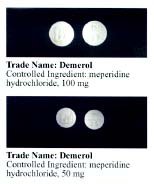|
Oxpheneridine
OxpheneridineCS Patent 109234 is a 4-phenylpiperidine derivative that is related to the opioid analgesic drug pethidine (meperidine). Oxpheneridine is not currently used in medicine. Presumably it has similar effects to other opioid derivatives, such as analgesia, sedation, nausea and respiratory depression. Unlike most opioid derivatives, oxpheneridine is not specifically listed as an illegal drug. In the UNODC narcotics report of 1958, they state that it was not possible to administer oxpheneridine in high doses as it is poorly soluble and highly irritating, and at the low doses administered it did not produce addiction in animals. This appears to be the only time oxpheneridine has been investigated, and so its pharmacological properties have not been well established. Oxpheneridine would probably be regarded as a controlled substance analogue of pethidine on the grounds of its related chemical structure in some jurisdictions such as the United States, Australia and New Ze ... [...More Info...] [...Related Items...] OR: [Wikipedia] [Google] [Baidu] |
Phenyl
In organic chemistry, the phenyl group, or phenyl ring, is a cyclic group of atoms with the formula C6 H5, and is often represented by the symbol Ph. Phenyl group is closely related to benzene and can be viewed as a benzene ring, minus a hydrogen, which may be replaced by some other element or compound to serve as a functional group. Phenyl group has six carbon atoms bonded together in a hexagonal planar ring, five of which are bonded to individual hydrogen atoms, with the remaining carbon bonded to a substituent. Phenyl groups are commonplace in organic chemistry. Although often depicted with alternating double and single bonds, phenyl group is chemically aromatic and has equal bond lengths between carbon atoms in the ring. Nomenclature Usually, a "phenyl group" is synonymous with C6H5− and is represented by the symbol Ph or, archaically, Φ. Benzene is sometimes denoted as PhH. Phenyl groups are generally attached to other atoms or groups. For example, triphenylmethane (Ph3 ... [...More Info...] [...Related Items...] OR: [Wikipedia] [Google] [Baidu] |
Opioid
Opioids are substances that act on opioid receptors to produce morphine-like effects. Medically they are primarily used for pain relief, including anesthesia. Other medical uses include suppression of diarrhea, replacement therapy for opioid use disorder, reversing opioid overdose, and suppressing cough. Extremely potent opioids such as carfentanil are approved only for veterinary use. Opioids are also frequently used non-medically for their euphoric effects or to prevent withdrawal. Opioids can cause death and have been used for executions in the United States. Side effects of opioids may include itchiness, sedation, nausea, respiratory depression, constipation, and euphoria. Long-term use can cause tolerance, meaning that increased doses are required to achieve the same effect, and physical dependence, meaning that abruptly discontinuing the drug leads to unpleasant withdrawal symptoms. The euphoria attracts recreational use, and frequent, escalating recreational use of ... [...More Info...] [...Related Items...] OR: [Wikipedia] [Google] [Baidu] |
Secondary Alcohols
In chemistry, an alcohol is a type of organic compound that carries at least one hydroxyl () functional group bound to a saturated carbon atom. The term ''alcohol'' originally referred to the primary alcohol ethanol (ethyl alcohol), which is used as a drug and is the main alcohol present in alcoholic drinks. An important class of alcohols, of which methanol and ethanol are the simplest examples, includes all compounds which conform to the general formula . Simple monoalcohols that are the subject of this article include primary (), secondary () and tertiary () alcohols. The suffix ''-ol'' appears in the IUPAC chemical name of all substances where the hydroxyl group is the functional group with the highest priority. When a higher priority group is present in the compound, the prefix ''hydroxy-'' is used in its IUPAC name. The suffix ''-ol'' in non-IUPAC names (such as paracetamol or cholesterol) also typically indicates that the substance is an alcohol. However, some compound ... [...More Info...] [...Related Items...] OR: [Wikipedia] [Google] [Baidu] |
Synthetic Opioids
Opioids are substances that act on opioid receptors to produce morphine-like effects. Medically they are primarily used for pain relief, including anesthesia. Other medical uses include suppression of diarrhea, replacement therapy for opioid use disorder, reversing opioid overdose, and suppressing cough. Extremely potent opioids such as carfentanil are approved only for veterinary use. Opioids are also frequently used non-medically for their euphoric effects or to prevent withdrawal. Opioids can cause death and have been used for executions in the United States. Side effects of opioids may include itchiness, sedation, nausea, respiratory depression, constipation, and euphoria. Long-term use can cause tolerance, meaning that increased doses are required to achieve the same effect, and physical dependence, meaning that abruptly discontinuing the drug leads to unpleasant withdrawal symptoms. The euphoria attracts recreational use, and frequent, escalating recreational use of ... [...More Info...] [...Related Items...] OR: [Wikipedia] [Google] [Baidu] |
Fentanyl
Fentanyl, also spelled fentanil, is a very potent synthetic opioid used as a pain medication. Together with other drugs, fentanyl is used for anesthesia. It is also used illicitly as a recreational drug, sometimes mixed with heroin, cocaine, benzodiazepines or methamphetamine, among others. Its potentially deadly overdose effects can be neutralized by naloxone. Fentanyl is commonly used to create counterfeit pills disguised as OxyContin, Xanax, Adderall, among others. It has a rapid onset and its effects generally last under two hours. Medically, it is used by injection, nasal spray, or skin patch, or absorbed through the cheek as a lozenge or tablet. Common adverse effects of fentanyl include nausea, vomiting, constipation, itching, sedation, confusion, and injuries related to poor coordination. Serious adverse effects may include respiratory depression, hallucinations, serotonin syndrome, low blood pressure, or development of an opioid use disorder. Fentanyl works b ... [...More Info...] [...Related Items...] OR: [Wikipedia] [Google] [Baidu] |
Pheneridine
Pheneridine is a 4-Phenylpiperidine derivative that is related to the opioid analgesic drug pethidine (meperidine). Pheneridine is not currently used in medicine. Presumably it has similar effects to other opioid derivatives, such as analgesia, sedation, nausea and respiratory depression Hypoventilation (also known as respiratory depression) occurs when ventilation is inadequate (''hypo'' meaning "below") to perform needed respiratory gas exchange. By definition it causes an increased concentration of carbon dioxide (hypercapnia ..., however unlike most opioid derivatives it is not specifically listed as an illegal drug, although it would probably be regarded as a controlled substance analogue of pethidine on the grounds of its related chemical structure in some jurisdictions such as the United States, Canada and Australia, and would be classified as a "Pethidine Analogue" under the New Zealand Misuse of Drugs Act Class C7. References Synthetic opioids 4-Phenylpiperi ... [...More Info...] [...Related Items...] OR: [Wikipedia] [Google] [Baidu] |
Meperidine
Pethidine, also known as meperidine and sold under the brand name Demerol among others, is a synthetic opioid analgesic, pain medication of the phenylpiperidine class. Synthesized in 1938 as a potential anticholinergic agent by the German chemist Otto Eisleb, its analgesic properties were first recognized by Otto Schaumann while working for IG Farben, Germany. Pethidine is the prototype of a large family of analgesics including the pethidine 4-phenylpiperidines (piminodine, anileridine and others), the prodines (alphaprodine, MPPP, ''etc.''), bemidones (ketobemidone, etc.) and others more distant, including diphenoxylate and analogues. Pethidine is indicated for the treatment of moderate to severe pain, and is delivered as a hydrochloride salt in tablets, as a syrup, or by intramuscular, Subcutaneous injection, subcutaneous, or intravenous injection. For much of the 20th century, pethidine was the opioid of choice for many physicians; in 1975, 60% of doctors prescribed it for acu ... [...More Info...] [...Related Items...] OR: [Wikipedia] [Google] [Baidu] |
Federal Analog Act
The Federal Analogue Act, , is a section of the United States Controlled Substances Act passed in 1986 which allows any chemical "substantially similar" to a controlled substance listed in Controlled Substances Act#Schedule I controlled substances, Schedule I or Controlled Substances Act#Schedule II controlled substances, II to be treated as if it were listed in Schedule I, but only if intended for human consumption. These similar substances are often called designer drugs. The law's constitutionality has been questioned by now Supreme Court Justice Neil Gorsuch; its broad reach has been used to successfully prosecute possession of chemicals openly sold as dietary supplements and naturally contained in foods such as chocolate. Definition (32) *(A) Except as provided in subparagraph (C), the term ''controlled substance analogue'' means a substance - **(i) the chemical structure of which is substantially similar to the chemical structure of a controlled substance in schedule I or I ... [...More Info...] [...Related Items...] OR: [Wikipedia] [Google] [Baidu] |
Piperidine
Piperidine is an organic compound with the molecular formula (CH2)5NH. This heterocyclic compound, heterocyclic amine consists of a six-membered ring containing five methylene bridges (–CH2–) and one amine bridge (–NH–). It is a colorless liquid with an odor described as objectionable, and typical of amines. The name comes from the genus name ''Piper (genus), Piper'', which is the Latin word for Black pepper, pepper. Although piperidine is a common organic compound, it is best known as a representative structure element within many pharmaceuticals and alkaloids, such as natural-occurring Solenopsin, solenopsins. Production Piperidine was first reported in 1850 by the Scottish chemist Thomas Anderson (chemist), Thomas Anderson and again, independently, in 1852 by the French chemist Auguste André Thomas Cahours, Auguste Cahours, who named it. Both of them obtained piperidine by reacting piperine with nitric acid. Industrially, piperidine is produced by the hydrogenation o ... [...More Info...] [...Related Items...] OR: [Wikipedia] [Google] [Baidu] |
UNODC
The United Nations Office on Drugs and Crime (UNODC; French: ''Office des Nations unies contre la drogue et le crime'') is a United Nations office that was established in 1997 as the Office for Drug Control and Crime Prevention by combining the United Nations International Drug Control Program (UNDCP) and the Crime Prevention and Criminal Justice Division in the United Nations Office at Vienna and was renamed the United Nations Office on Drugs and Crime in 2002. The agency's focus is the trafficking in and abuse of illicit drugs, crime prevention and criminal justice, international terrorism, and political corruption. It is a member of the United Nations Development Group. In 2016–2017 it had an estimated biannual budget of US$700 million. History The United Nations International Drug Control Program (UNDCP) and the Crime Prevention and Criminal Justice Division in the United Nations Office at Vienna were merged to form the Office for Drug Control and Crime Prevention. This wa ... [...More Info...] [...Related Items...] OR: [Wikipedia] [Google] [Baidu] |





